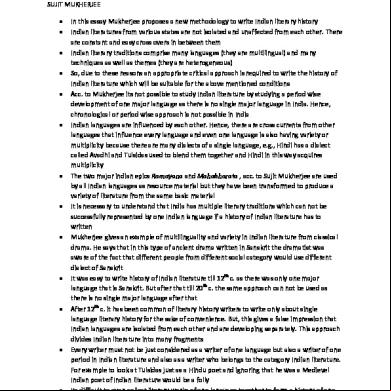Unit-1_1 582r3n
This document was ed by and they confirmed that they have the permission to share it. If you are author or own the copyright of this book, please report to us by using this report form. Report 3b7i
Overview 3e4r5l
& View Unit-1_1 as PDF for free.
More details w3441
- Words: 1,356
- Pages: 3
UNIT-1 OVERVIEW Propositions SUJIT MUKHERJEE • • • • •
•
•
•
•
•
•
•
•
In this essay Mukherjee proposes a new methodology to write Indian literary history Indian literatures from various states are not isolated and unaffected from each other. There are constant and easy cross overs in between them Indian literary traditions comprise many languages (they are multilingual) and many techniques as well as themes (they are heterogeneous) So, due to these reasons an appropriate critical approach is required to write the history of Indian literature which will be suitable for the above mentioned conditions Acc. to Mukherjee its not possible to study Indian literature by studying a period wise development of one major language as there is no single major language in India. Hence, chronological or period wise approach is not possible in India Indian languages are influenced by each other. Hence, there are cross currents from other languages that influence every language and even one language is also having variety or multiplicity because there are many dialects of a single language, e.g., Hindi has a dialect called Avadhi and Tulsidas used to blend them together and Hindi in this way acquires multiplicity The two major indian epics Ramayana and Mahabharata , acc. to Sujit Mukherjee are used by all Indian languages as resource material but they have been transformed to produce a variety of literature from the same basic material It is necessary to understand that India has multiple literary traditions which can not be successfully represented by one Indian language if a history of Indian literature has to written Mukherjee gives an example of multilinguality and variety in Indian literature from classical drama. He says that in this type of ancient drama written in Sanskrit the dramatist was aware of the fact that different people from different social category would use different dialect of Sanskrit It was easy to write history of Indian literature till 12th c. as there was only one major language that is Sanskrit. But after that till 20th c. the same approach can not be used as there is no single major language after that After 12th c. it has been common of literary history writers to write only about single language literary history for the sake of convenience. But, this gives a false impression that Indian languages are isolated from each other and are developing separately. This approach divides Indian literature into many fragments Every writer must not be just considered as a writer of one language but also a writer of one period in Indian literature and also as a writer who belongs to the category Indian literature. For example to look at Tulsidas just as a Hindu poet and ignoring that he was a Medievel Indian poet of Indian literature would be a folly Its difficult to even collect literary works of one language together to form a history of one language in India as every indian language is influenced by other Indian languages. For
• •
•
•
•
•
•
• •
• • • •
•
example in Tulsidas’s work its difficult to say if he has written in Hindi or Avadhi. We don’t know whether to place him in the history of Hindi lit. or Avadhi lit. Acc. to Mukherjee, it is not suitable to study history and development in Indian literatures as separate languages. A broad minded approach is required. Literary tradition of India as suggested by D.P. Mukherji, should be studied by crossing the barriers of one language and also by using an interdisciplinary approach (studying not only literature but also music, painting and other arts which developed in a particular period to which the literary work belonged. This is to see how a literary work was inspired from other forms of arts) However, a multi-lingual approach to study Indian literature can pose difficulties as it is not possible by a literary historian to be an expert of so many languages. The solution of this problem is to read the works of unknown languages in translation To study literature we must identify which works are literary and which are non-literary. Literary works must have rasa (emotions which give artistic delight). Only works with rasa are fit to be studies and included in a literary history Although very less is known by Indian writers till 18th c. but we must try to gain as much knowledge of the writer as possible. It is important to study the writer to know about the culture of his period and to establish a relation between literary culture and the writer Indian writer, his times, his career and its relation to Indian literary history is very important for us. Indian writer was considered a divine being (inspired directly from God’s words) till Vedic lit. only. After Vedic lit. , Indian writer has always been a committed member of Indian society. His role is not just as a writer in literary history but also as a religious and social reformer from Middle ages of India onwards. Indian writer’s role is active Another point to consider is that many literary forms like gatha and vachana are also not exclusive to one language or state. Indian literary forms (like Indian languages and themes) influence many writers of different languages and areas (see example, page-14, 2nd para) Folk lit. has also been a source of many new form sof Indian lit. For example, Indian drama has been developed from Indian folk forms Indian literary forms have also been influenced by foreign literary forms. Modern Indian novel is influenced from Western novel from. But, Indian novelists have used this lit. form to talk about Indian social and political conditions Indian literary forms have matured and have conventions (basis rules and styles) of their own. Every regional lit. style has its own conventions Modern Indian lit. like ancient classical lit. is under great influence of one major language. In the case of classical lit. it was Sanskrit and in the case of modern Indian lit. it is English The problem of Modern Indian writer is that he wants to embrace English and Western influence yet he wants to base his writing in Indian culture Modern Indian writers have combined both old classical and new Western influences in their writings to such an extent that it is difficult for the Indian literary historian to find out as to which conventions are these writers following. This is one of the difficulties of Indian literary historian Acc. to Mukherjee, it would be fruitful to study how a major language like Sanskrit influenced the lit. of other regional languages. This multilingual approach would further prove that all literatures of different Indian languages share the same Indian cultural base
•
• • •
• •
• •
Valmiki’s Ramayana can also be called a part of Indian tradition as it is called “adi kavya” and a source of Indian values (sanskaar) and more importantly it has served as a source for many other literary works Ramayana has been used as a source literature and has been recreated into lit. of many languages (see page-14, last para for examples) All these recreated and autonomous works based on Ramayana belong to Ramayana tradition As Ramayana tradition gave rise to Ram-Bhakti tradition, in the similar manner Bhagwat Purana gave rise to Krishna-Bhakti tradition which inspired the Bhakti Movement from 15th17th c. All these traditions are across languages which reinforce the idea of cultural integrity of Indian lit. Our great national epic Mahabharata could not be recreated fully (like Ramayana) because its too large, but its many episodes have been used as source material in new lit. works across India Mahabharata has been used as a sorcebook of themes and stories by modern Indian writers in many diff. forms (see page 15, para 5 for examples) All Indian literatures in diff. languages across India have sourced themes, stories and ideas from Ramayana, Mahabharata, puranas, Brahmanas, Upanishadas, and South Indian Sangam poetry. Hence, we can say with confidence that literary works of diff. regions of India are only diff. in language but their tradition is Indian
•
•
•
•
•
•
•
•
In this essay Mukherjee proposes a new methodology to write Indian literary history Indian literatures from various states are not isolated and unaffected from each other. There are constant and easy cross overs in between them Indian literary traditions comprise many languages (they are multilingual) and many techniques as well as themes (they are heterogeneous) So, due to these reasons an appropriate critical approach is required to write the history of Indian literature which will be suitable for the above mentioned conditions Acc. to Mukherjee its not possible to study Indian literature by studying a period wise development of one major language as there is no single major language in India. Hence, chronological or period wise approach is not possible in India Indian languages are influenced by each other. Hence, there are cross currents from other languages that influence every language and even one language is also having variety or multiplicity because there are many dialects of a single language, e.g., Hindi has a dialect called Avadhi and Tulsidas used to blend them together and Hindi in this way acquires multiplicity The two major indian epics Ramayana and Mahabharata , acc. to Sujit Mukherjee are used by all Indian languages as resource material but they have been transformed to produce a variety of literature from the same basic material It is necessary to understand that India has multiple literary traditions which can not be successfully represented by one Indian language if a history of Indian literature has to written Mukherjee gives an example of multilinguality and variety in Indian literature from classical drama. He says that in this type of ancient drama written in Sanskrit the dramatist was aware of the fact that different people from different social category would use different dialect of Sanskrit It was easy to write history of Indian literature till 12th c. as there was only one major language that is Sanskrit. But after that till 20th c. the same approach can not be used as there is no single major language after that After 12th c. it has been common of literary history writers to write only about single language literary history for the sake of convenience. But, this gives a false impression that Indian languages are isolated from each other and are developing separately. This approach divides Indian literature into many fragments Every writer must not be just considered as a writer of one language but also a writer of one period in Indian literature and also as a writer who belongs to the category Indian literature. For example to look at Tulsidas just as a Hindu poet and ignoring that he was a Medievel Indian poet of Indian literature would be a folly Its difficult to even collect literary works of one language together to form a history of one language in India as every indian language is influenced by other Indian languages. For
• •
•
•
•
•
•
• •
• • • •
•
example in Tulsidas’s work its difficult to say if he has written in Hindi or Avadhi. We don’t know whether to place him in the history of Hindi lit. or Avadhi lit. Acc. to Mukherjee, it is not suitable to study history and development in Indian literatures as separate languages. A broad minded approach is required. Literary tradition of India as suggested by D.P. Mukherji, should be studied by crossing the barriers of one language and also by using an interdisciplinary approach (studying not only literature but also music, painting and other arts which developed in a particular period to which the literary work belonged. This is to see how a literary work was inspired from other forms of arts) However, a multi-lingual approach to study Indian literature can pose difficulties as it is not possible by a literary historian to be an expert of so many languages. The solution of this problem is to read the works of unknown languages in translation To study literature we must identify which works are literary and which are non-literary. Literary works must have rasa (emotions which give artistic delight). Only works with rasa are fit to be studies and included in a literary history Although very less is known by Indian writers till 18th c. but we must try to gain as much knowledge of the writer as possible. It is important to study the writer to know about the culture of his period and to establish a relation between literary culture and the writer Indian writer, his times, his career and its relation to Indian literary history is very important for us. Indian writer was considered a divine being (inspired directly from God’s words) till Vedic lit. only. After Vedic lit. , Indian writer has always been a committed member of Indian society. His role is not just as a writer in literary history but also as a religious and social reformer from Middle ages of India onwards. Indian writer’s role is active Another point to consider is that many literary forms like gatha and vachana are also not exclusive to one language or state. Indian literary forms (like Indian languages and themes) influence many writers of different languages and areas (see example, page-14, 2nd para) Folk lit. has also been a source of many new form sof Indian lit. For example, Indian drama has been developed from Indian folk forms Indian literary forms have also been influenced by foreign literary forms. Modern Indian novel is influenced from Western novel from. But, Indian novelists have used this lit. form to talk about Indian social and political conditions Indian literary forms have matured and have conventions (basis rules and styles) of their own. Every regional lit. style has its own conventions Modern Indian lit. like ancient classical lit. is under great influence of one major language. In the case of classical lit. it was Sanskrit and in the case of modern Indian lit. it is English The problem of Modern Indian writer is that he wants to embrace English and Western influence yet he wants to base his writing in Indian culture Modern Indian writers have combined both old classical and new Western influences in their writings to such an extent that it is difficult for the Indian literary historian to find out as to which conventions are these writers following. This is one of the difficulties of Indian literary historian Acc. to Mukherjee, it would be fruitful to study how a major language like Sanskrit influenced the lit. of other regional languages. This multilingual approach would further prove that all literatures of different Indian languages share the same Indian cultural base
•
• • •
• •
• •
Valmiki’s Ramayana can also be called a part of Indian tradition as it is called “adi kavya” and a source of Indian values (sanskaar) and more importantly it has served as a source for many other literary works Ramayana has been used as a source literature and has been recreated into lit. of many languages (see page-14, last para for examples) All these recreated and autonomous works based on Ramayana belong to Ramayana tradition As Ramayana tradition gave rise to Ram-Bhakti tradition, in the similar manner Bhagwat Purana gave rise to Krishna-Bhakti tradition which inspired the Bhakti Movement from 15th17th c. All these traditions are across languages which reinforce the idea of cultural integrity of Indian lit. Our great national epic Mahabharata could not be recreated fully (like Ramayana) because its too large, but its many episodes have been used as source material in new lit. works across India Mahabharata has been used as a sorcebook of themes and stories by modern Indian writers in many diff. forms (see page 15, para 5 for examples) All Indian literatures in diff. languages across India have sourced themes, stories and ideas from Ramayana, Mahabharata, puranas, Brahmanas, Upanishadas, and South Indian Sangam poetry. Hence, we can say with confidence that literary works of diff. regions of India are only diff. in language but their tradition is Indian







